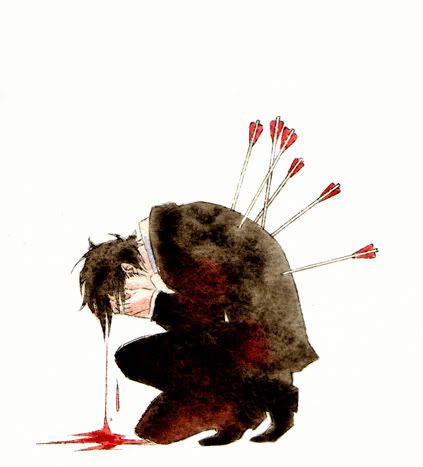 I considered myself extremely lucky when Joanna Estep agreed to interview for Rococo Flow. The fact that she isn’t too fond of interviews and gave me a sneak peak of Roadsong 3 makes me even more grateful. Best known as the artist and co-creator for the Tokyopop series Roadsong, she is also the co-founder of Milktooth Press. On top of that, she also wrote the textbook Timing: Expressions of Time in Sequential Art and Design, which received the Charles Logan Smith Award for excellence in design. Now for the reason why I love her work: Joanna has such a great combination of style and color. Not to mention, her ink work is to die for. Born on February 18, 1981, Joanna is from Dayton, Ohio and got her start in comics by drawing short stories for various anthologies. When she’s not working on a project, she’s simply a girl who loves movies, writing, role-playing, camping, and going for drives.
I considered myself extremely lucky when Joanna Estep agreed to interview for Rococo Flow. The fact that she isn’t too fond of interviews and gave me a sneak peak of Roadsong 3 makes me even more grateful. Best known as the artist and co-creator for the Tokyopop series Roadsong, she is also the co-founder of Milktooth Press. On top of that, she also wrote the textbook Timing: Expressions of Time in Sequential Art and Design, which received the Charles Logan Smith Award for excellence in design. Now for the reason why I love her work: Joanna has such a great combination of style and color. Not to mention, her ink work is to die for. Born on February 18, 1981, Joanna is from Dayton, Ohio and got her start in comics by drawing short stories for various anthologies. When she’s not working on a project, she’s simply a girl who loves movies, writing, role-playing, camping, and going for drives.
Rococo Flow: So how long have you been drawing? Did you go to an art school?
Joanna: Well, I'm pretty sure that I decided to be an artist, back when I was in elementary school. You know, that whole "Mommy I'm going be an artist when I grow up!" sort of thing. It wasn't until much later, (high school) that I figured out exactly what sort of artist I wanted to be. When the comics bug bit, it bit hard and a lot of my friends were drawing comics too, so we all encouraged each other. I did indeed go to art school (Ohio University), though I decided I needed a practical plan B, if comics didn't pan out as a valid career option. So I majored in graphic design, which I now understand to have been the right choice for me.
Rococo Flow: Why is that? Did the things you learned in graphic design help with the comic layouts and such?
Joanna: It helped in several different ways, I think. The most obvious being that I learned to work with a lot of different design software, and also about the printing process, and how to get the best output for what you're printing; color, black and white, or otherwise. That's helped a lot, because most of the comics I draw end up in print.
Layouts are another big thing. You have to have an eye for that stuff, and it can take a long time to develop that "eye". I'd say that the number one way to tell an experienced comic artist from an inexperienced one is to look at the layouts, and they way they design their page. It can take a very long time, to cultivate good instincts for that, and design school definitely helped me with that. Rococo Flow: So as you've learned and become better at your craft, who have been your influences?
Rococo Flow: So as you've learned and become better at your craft, who have been your influences?
Joanna: Good question! I always struggle with this one. I think I have more artists/comickers who inspire me, rather than influence me. Some of the first comics I read were things like Jeff Smith's Bone or Moto Hagio's A,A or Elfquest, even.
As for the more direct influences, I grew up being friends and acquaintances with a lot of other comic artists. I went to high school with the artists Traci Spencer, Robin Edwards, and also Leia Weathington. (All three of whom now make web comics of growing renown.) I was also distantly acquainted with the creative collective Estrigious, and consequently drew a great deal of influence from them as well.
Nowadays, I'm hugely influenced by my peers at Tokyopop, and Insight Studios Group. Mark Wheatley, (Head honcho of Insight) has been a huge help and inspiration to me. He's like my comics dad.
Rococo Flow: How would describe your own style?
Joanna: Hmmm, now there's another tough one. I like to draw in a lot of different styles, actually. People tell me that my stuff is recognizable no matter what I'm doing, but I sometimes worry that I'm too experimental for my own good. Most of the comics I've drawn so far have been pretty light-hearted, so when I'm comicking I draw with a style that I hope comes across as humorous, expressive, and full of movement. (It’s to the point where I often get asked if I work in animation.)
However, I not-so-secretly hope to draw darker stories someday, so a lot of the sketching and illustration I do on my own time comes across as grim and heavy-handed, and with copious amounts of India ink.
That's probably not the answer you were looking for, but it’s pretty hard to classify myself. Rococo Flow: That’s quite alright. I thought it would be hard for most people, however I wanted to give artists a chance to classify themselves. So when working on a story or any artwork, how do you get ideas?
Rococo Flow: That’s quite alright. I thought it would be hard for most people, however I wanted to give artists a chance to classify themselves. So when working on a story or any artwork, how do you get ideas?
Joanna: Lately, I feel like the question should be: "How do I not get ideas?" Loads of things inspire me, and I sort of end up with this mental checklist of things I'd like to draw and/or write. I try to get to them all in a timely fashion, but sometimes it's all work and no play, so I have to let some ideas go.
But if I'm aiming to start a more serious project, I'll just think to myself: "Hmmm, what are some things I like to draw, and how can I write them all into a story together?" Things always seem to just snowball, from there. When I'm doing a big comic project, it's always a safe bet to include things that I enjoy drawing, because I'll have to draw them over and over and over...
Rococo Flow: Could you describe your general approach to creating a picture?
Joanna: I throw some ink on a page and scribble it around!!... Okay not really, thought it feels like that some days. If it's comics, I generally start by sketching a rough layout at print size. Then I scan the layout into my computer and resize it to match the larger board that I'll be drawing on. After that, I use my lightbox to trace the layout onto the board, and to tighten up the pencils as I go. It feels tedious sometimes, but I find that it preserves the gesture and energy of my initial layouts. If it's not a comic then anything goes. Sometimes I do the resize-and-trace method, sometimes not. It depends on the illustration. Rococo Flow: What programs do you primarily use for your comics and your illustration work?
Rococo Flow: What programs do you primarily use for your comics and your illustration work?
Joanna: Eh, these days it's mostly Photoshop. I used to use InDesign for lettering and book layout, but it's since become easy to do those things in Photoshop too.
Rococo Flow: True, Photoshop has sort of become an industry standard. When it comes to traditional media, what's your favorite? (I'm particularly fond of your ink work).
Joanna: Ink, ink, ink, ink, and more ink. I love to sling ink around, and I buy lots of different inking tools just to try them out. I don’t know, I think that stark black and white images and confident brush strokes are just exceptionally beautiful. I know some artists ink digitally, but I love the hands-on stuff.
Rococo Flow: So is inking your favorite part of the creating process?
Joanna: I think so. For me, the two most exciting moments in making comics, is when I finish a layout, or finish inking a page. Those are the times when I can see/imagine what the page is going to look like when it's complete, so yeah, I guess you could say it's my favorite part.
Rococo Flow: What's your least favorite part then?
Joanna: Scanning stuff in and tracing layouts back onto the board. I do it a lot and it gets pretty tedious. I'm not crazy about penciling, either. I don't usually like the way my pencils look.
Rococo Flow: I thought it was the reverse for most people. That they wish their inks looked as good as their pencils.
Joanna: Really? I haven't heard that one in a long time.
Rococo Flow: Hmm, maybe it's just me, but then again, I would think it depends on the kind of work you do. I've seen some people who paint straight onto a sketch, but that's illustration. For comics you need to be able to ink (or have someone do it for you).
Joanna: Not always! Inking is not really a requirement to make sequential art. Some artists paint. Some just color on their pencils. Some just pencil and don't even bother with inks. Inking is common, but it's not the only way to make good comics.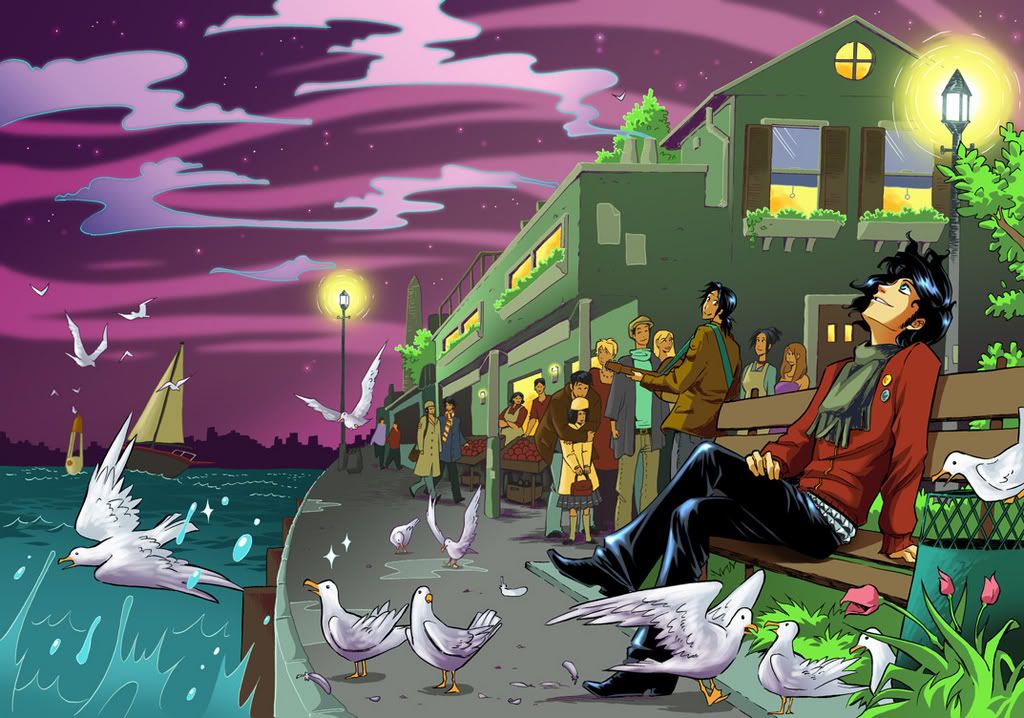 Rococo Flow: True, I see your point. In regards to comics then, how'd you get involved with working for Tokyopop?
Rococo Flow: True, I see your point. In regards to comics then, how'd you get involved with working for Tokyopop?
Joanna: There's sort of a long and winding answer to that one, actually. I was in the habit of taking my portfolio to comic conventions so that I could get feedback and advice from the working professionals. At the time, I was getting interested in self-publishing, but I happened to meet Mark Wheatley of Insight Studios and he seemed to really like my work. He put me in touch with Allan Gross (writer of Roadsong) and we started a comic that we initially intended to publish in Triathlete Magazine. That project soon fell through, but Al had a few contacts at Tokyopop and he was able to get us a gig making manga. The rest is history.
Rococo Flow: How does the creative process work for the graphic novel Roadsong, since you work with a writer?
Joanna: It's pretty simple, really, and it involves a lot of trading around of the script. Al and I usually discuss the general concepts and direction of the story before or during the writing of the script. Then when it's written he'll send it to me, and to our editor. I used to offer more feedback to the script at this point, but our editor is pretty trustworthy, and she usually says everything that I want to say, anyway.
In any case, when we've settled on a script, I make the page layouts for the book, and send those off to be edited, too. After that, I'm free to draw! And it isn't until the artwork for the book is finished that Al goes back to include what he calls the "lettering script". That's when he tweaks and modifies the dialogue to (hopefully) better suit the art.
Rococo Flow: It sounds like you're a very busy person. What's your work environment like? Can you describe the life of a comic book artist? Especially for those who seriously want to get into the business.
Joanna: You know, I always wonder if people have this image of comic artists as having this exciting and glamorous lifestyle. I mean, it's really just me sitting around in my pajamas all day, chained to the art desk. Very boring…Okay, so that's a slight exaggeration, but it's not too far from the truth. I have a cozy office that I use for art-making and storing reference material and supplies. Sometimes I like a change of scenery though, so I'll go draw at a coffee shop, or a friend's house. I live right by webcomic artist Traci Spencer, so the two of us work on comics together a lot.
Rococo Flow: Well you seem to like it well enough. Do you have any other projects in the works? Maybe one in which you work as both writer and artist?
Joanna: I do indeed! I'm on the verge of selling a proposal for a new story, and I'm very excited to be able to write again! I don't want to say too much about it at this point, but it's an "Oliver Twist" meets "Multiplicity" sort of story. (I laugh every time I say that, but it's pretty true.) I look forward to starting work on it in earnest.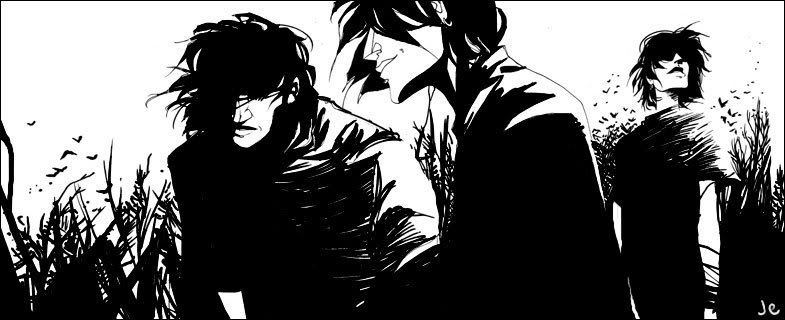
Rococo Flow: Sounds exciting can’t wait.
Joanna: It's a long ways off, yet. I'm still working on Roadsong 3. :-)
Rococo Flow: I guess people will just have to be patient then. I also wanted to know about your thoughts on the comic industry? With the boom of manga and Eastern influenced comics, there seems to be a lot more females who are being recognized in the industry.
Joanna: Ergh, I hardly feel like an expert on the state of the industry. There are a lot of things I like, but there's still a lot to complain about, too. So rather than open that particular can of worms, I might just say that I'm mostly glad for the recent surge in the production of western manga, and manga influenced comics. There are a lot of girls who like to draw manga, and are really excellent at it too. I'm glad that this recent trend has allowed them the chance to share their work with a wider audience.
Rococo Flow: So what are your own goals for the future?
Joanna: Hah. When I was last asked about my hopes and dreams, I replied by saying "financial stability." It's still pretty true. I love making comics, and it's great to have a career in the industry, but it can take awhile to get to the point where you're living comfortably on it. I still take second jobs, sometimes.
Rococo Flow: I see, I guess the thought of a glamorous life that other people think of, are thoughts of automatically getting a hit cartoon/anime made just because you work on a project. However, I like to believe that the industry is still growing and it'll become a lot better for many artists like you.
Joanna: I certainly hope so. I'm part of this recent boom of graphic novels over single-issue comics, so I feel like I'm just one of many guinea pigs, in this whole endeavor. I think things will even out eventually, but things are still a little rocky. It can be hard to hold onto an audience for a graphic novel series, when you can only produce one book a year. Speaking from experience, I wonder if maybe creators who are drawing entire books at a time are more likely to suffer from exhaustion and burnout, too. As for cartoons and anime though? Just love your comic for what it is. I dislike it when comics are treated as stepping stones to TV and movies. Comics are fantastic, all on their own!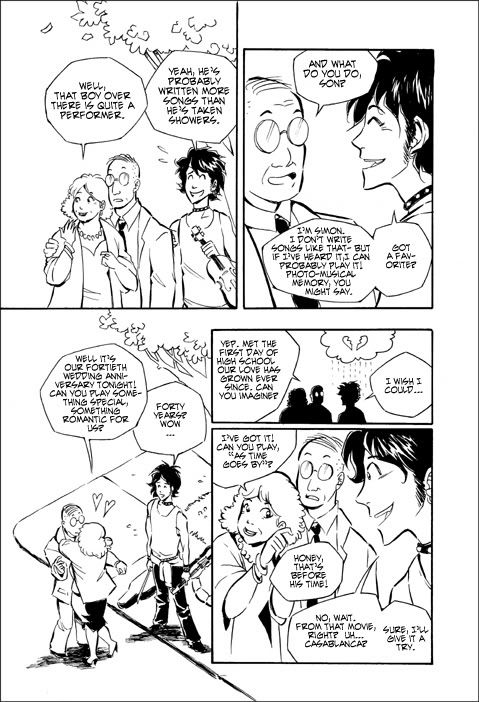 Rococo Flow: Your comment about burnout is interesting because I think some people fail to realize that most times 'OEL manga' or whatever they want to call it is usually done by one person when it comes to the art. While a lot of Japanese creators have a lot of assistants who can help with the other stuff.
Rococo Flow: Your comment about burnout is interesting because I think some people fail to realize that most times 'OEL manga' or whatever they want to call it is usually done by one person when it comes to the art. While a lot of Japanese creators have a lot of assistants who can help with the other stuff.
Joanna: Right. The American comics industry doesn't easily lend itself to that sort of thing. At the moment it's just me, myself, and I. But that isn't to say that American comic artists can't or don't have assistants. Some of my friends do, and I'm also thinking of looking for an assistant if I get into a situation where I'm drawing more than one book at once.
Rococo Flow: Sounds, like it would at least lessen some of the burden. Do you have any advice for aspiring artists?
Joanna: Certainly. Make a lot of comics! Some of the most talented artists I know obsessively draw and make comics all the time, because they love it so much. No one can teach you more than you can teach yourself. When you've got that part down, I suggest taking your portfolio to comic conventions, and getting further advice from professionals. If you want to work in comics, networking with others in the industry is just as important as the drawing of said comics.
So go! Be free! Make art! Make friends!...or move to Ohio and become my assistant. ;-)
Rococo Flow: *laughs* Fun Question: If you could be any character from a video game, movie, or novel, etc. who would it be?
Joanna: Oh my god. Too hard, there are just so many choices... However, off the top of my head, I think I might like to be San, from Princess Mononoke or maybe Mowgli, from the jungle book? It's sort of a strange and irrational fantasy of mine to be a raised-by-wolves naked jungle girl. It probably wouldn't be much fun in practice, but I like to daydream about it.
Rococo Flow: I think I've asked that question in most of the interviews, but I always get interesting answers. (I can't help it!) Mowgli is awesome (at least in the Disney version).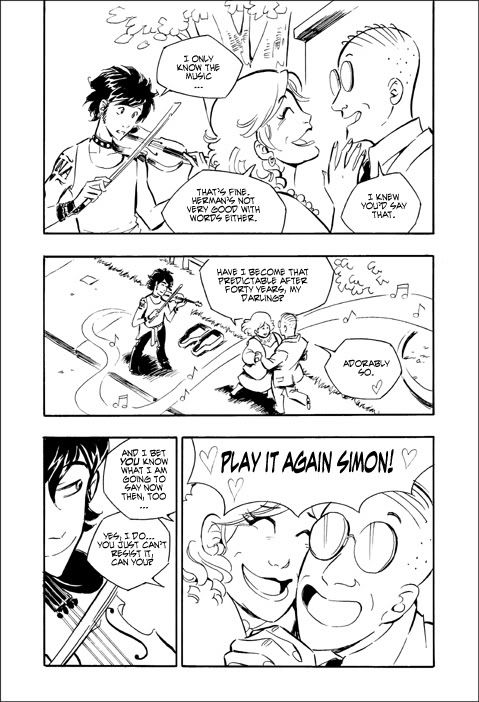
Joanna: Hee! I just love jungles and forests. It'd be so neat to live in the middle of one, but probably very dangerous. I'd likely get eaten.
Rococo Flow: *laughs* I think those are all the questions I've got. Do you have any other comments or things you'd like to address?
Joanna: Mm, not that I can think of at the moment. That was a pretty exhaustive interview.
Rococo Flow: Thank you!! I really appreciate your time.
Joanna: No problem. Don't be a stranger!
To see more work by Joanna visit these links:
http://www.joannaestep.com/ - Main website
http://jou.livejournal.com/ - Her blog
http://milktoothpress.com/ - Milktooth Press
Roadsong:
Roadsong 1
Roadsong 2
Newsarama articles on timing:
Timing 1
Timing 2
Timing 3
You can also email Joanna at joanna.estep@gmail.com
Tuesday, August 7, 2007
Artist Profile: Joanna Estep
Posted by
Rococo Flow
at
1:46 AM
![]()
Labels: Interview, Joanna Estep
Subscribe to:
Post Comments (Atom)






















No comments:
Post a Comment